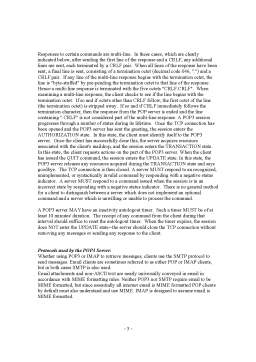Extras din referat
What is POP3?
POP3 is one half of the email puzzle, SMTP is the other. POP3 is the protocol, or "language", that's used to download your email from your ISP to your mail program. SMTP is the protocol used to send mail. Permits workstations to dynamically access a maildrop on a server host (TCP/IP). The most recent version of a standard client-server protocol for receiving e-mail. The default port on which the POP3 server listens for these requests is 110. Client side mail readers can issue a predefined set of commands to the mail server, to access the mail in their own desired fashion.
Post Office Protocol version 3 (POP3) is an application layer Internet standard protocol used to retrieve email from a remote server to a local client over a TCP/IP connection. Nearly all individual Internet service provider email accounts are accessed via POP3.
Characteristics:
The Post Office Protocol - Version 3 (POP3) is intended to permit a workstation to dynamically access a maildrop on a server host in a useful fashion. Usually, this means that the POP3 protocol is used to allow a workstation to retrieve mail that the server is
holding for it.
POP3 is not intended to provide extensive manipulation operations of mail on the server; normally, mail is downloaded and then deleted.
For the remainder of this memo, the term "client host" refers to a host making use of the POP3 service, while the term "server host" reffers to a host which offers the POP3 service.
Basic Operation:
Initially, the server host starts the POP3 service by listening on TCP port 110. When a client host wishes to make use of the service, it establishes a TCP connection with the server host. When the connection is established, the POP3 server sends a greeting. The
client and POP3 server then exchange commands and responses (respectively) until the connection is closed or aborted.
Commands in the POP3 consist of a case-insensitive keyword, possibly followed by one or more arguments. All commands are terminated by a CRLF pair. Keywords and arguments consist of printable ASCII characters. Keywords and arguments are each separated by a single SPACE character. Keywords are three or four characters long. Each argument may be up to 40 characters long.
Responses in the POP3 consist of a status indicator and a keyword possibly followed by additional information. All responses are terminated by a CRLF pair. Responses may be up to 512 characters long, including the terminating CRLF. There are currently two status indicators: positive ("+OK") and negative ("-ERR"). Servers MUST send the "+OK" and "-ERR" in upper case.
Responses to certain commands are multi-line. In these cases, which are clearly indicated below, after sending the first line of the response and a CRLF, any additional lines are sent, each terminated by a CRLF pair. When all lines of the response have been sent, a final line is sent, consisting of a termination octet (decimal code 046, ".") and a CRLF pair. If any line of the multi-line response begins with the termination octet, the line is "byte-stuffed" by pre-pending the termination octet to that line of the response.
Hence a multi-line response is terminated with the five octets "CRLF.CRLF". When examining a multi-line response, the client checks to see if the line begins with the termination octet. If so and if octets other than CRLF follow, the first octet of the line (the termination octet) is stripped away. If so and if CRLF immediately follows the termination character, then the response from the POP server is ended and the line containing ".CRLF" is not considered part of the multi-line response. A POP3 session progresses through a number of states during its lifetime. Once the TCP connection has been opened and the POP3 server has sent the greeting, the session enters the AUTHORIZATION state. In this state, the client must identify itself to the POP3 server. Once the client has successfully done this, the server acquires resources associated with the client's maildrop, and the session enters the TRANSACTION state. In this state, the client requests actions on the part of the POP3 server. When the client has issued the QUIT command, the session enters the UPDATE state. In this state, the POP3 server releases any resources acquired during the TRANSACTION state and says goodbye. The TCP connection is then closed. A server MUST respond to an recognized, unimplemented, or syntactically invalid command by responding with a negative status indicator. A server MUST respond to a command issued when the session is in an incorrect state by responding with a negative status indicator. There is no general method for a client to distinguish between a server which does not implement an optional command and a server which is unwilling or unable to process the command.
Preview document
Conținut arhivă zip
- Computer Networks Project.doc



















